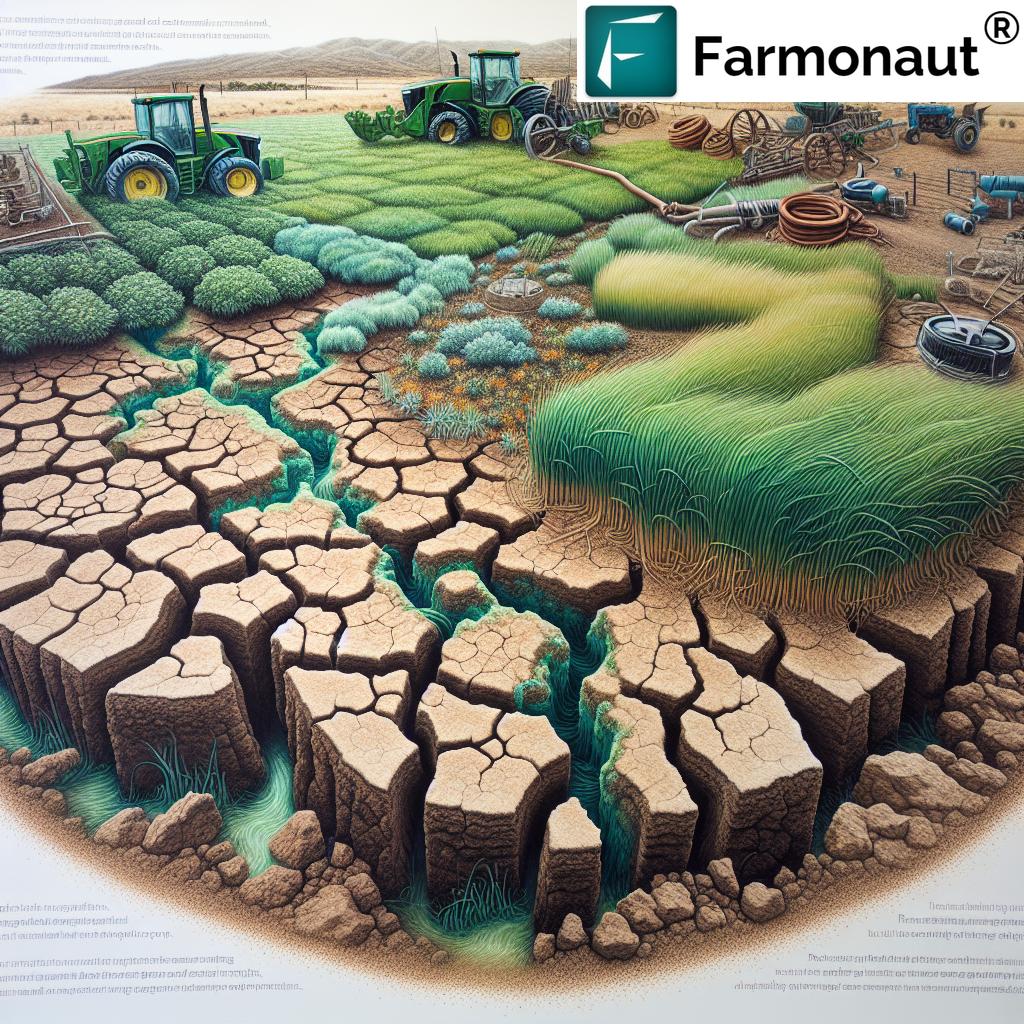Regenerative Farming in Arizona: 5 Proven Ways to Restore Soil
“Arizona’s regenerative farms can increase soil organic matter by up to 40% in just five years.”
Introduction to Regenerative Farming in Arizona
In the heart of the arid Southwest, regenerative farming in Arizona has become a beacon of hope for restoring soil, improving organic matter, and saving precious water. As drought and over-extraction of aquifers threaten the region’s agricultural future, we are witnessing a transformation in how farmers approach soil health, water management, and crop selection. Our journey is not easy—requiring significant investments in research, training, equipment, and refined techniques—but the potential rewards for our land, food, and community are profound.
Today, let’s dive deep into five proven soil restoration techniques that are reshaping Arizona’s fields, along with the innovation and sustainability these practices bring. We’ll unravel the processes required, the investments made, and the scientific insights gained along the way—highlighting what it takes to bring life back to compacted, saline, or degraded clay soils. And, with the integration of precision tools and advisory platforms, such as those offered by Farmonaut, we are moving toward a future where arid land farming is both productive and regenerative.
The Unique Challenges of Arizona’s Soil & Water
In Arizona, our land tells a tough story: compacted and salty soils, increased erosion, depleted aquifers, and the dominance of thirstier crops like cotton and alfalfa—all under the stress of climate change and a persistent megadrought. Our fields are often composed of over 55% clay, compacted through decades of conventional farming and years of neglect. As rivers and groundwater levels drop, every gallon of water used is scrutinized for efficiency.
- Decades of Conventional Practices: Overreliance on cotton and alfalfa has degraded the soil and depleted essential organic matter.
- Extreme Salinity & Erosion: Salts accumulate owing to over-irrigation and low organic content.
- Depleted Aquifers and Reduced Flow of Rivers: Unsustainable pumping threatens the future of the region’s farmland.
- Water-Intensive Crops: Crops like cotton typically demand 9-10 acre-feet of water per season—vastly outpacing more regenerative selections.
“Innovative water-saving techniques in Arizona’s regenerative agriculture reduce irrigation needs by as much as 30%.”
Five Proven Ways to Restore Soil: Regenerative Techniques
So, how do we restore degraded farmland, increase organic matter in soil, and reclaim lost productivity? The following soil restoration techniques—refined through years of research, practical application, and community insight—have proven transformative for Arizona’s arid farming landscape.
-
Cover Cropping for Soil Health
Cover crops for soil health are the cornerstone of regenerative farming. By planting legumes, grasses, and other fast-growing species between cash crop cycles, we replenish organic matter, reduce erosion, suppress weeds, and fix nitrogen in the soil. In the desert climate of Arizona, carefully selected drought-tolerant covers:
- Increase water infiltration and retention, reducing irrigation needs
- Break up compacted clay and mineralize locked nutrients
- Enhance soil biodiversity and microbiome health
Integrating available equipment for low-till or strip-till planting and incorporating manure or compost alongside cover crops multiplies benefits—accelerating the journey toward fertile, resilient fields.
-
Reduced Tillage & Strategic Grazing
Conventional farming often relies on frequent deep tillage—pulverizing soil structure, increasing evaporation, and leaving the land exposed to wind and water erosion. Shifting toward minimum tillage, coupled with strategic rotation of cattle or sheep, helps:
- Maintain ground cover and break compaction without destroying soil aggregates
- Facilitate the decomposition of plant residues for improved organic matter
- Promote deeper root penetration—improving water transport and infiltration
Modern ranch management now often includes rotational grazing and the use of modular, moveable fencing to evenly distribute manure deposits and minimize overgrazing impact on fields.
-
Sustainable Irrigation Methods
Water is the gating resource for farming in Arizona. Developing sustainable irrigation methods—drip systems, moisture sensors, and real-time flow tracking—enables us to maximize yield with the minimum possible gallons used. Practices include:
- Repairing wells and pump equipment to prevent leaks and ensure even distribution
- Excavating irrigation ditches and implementing smart scheduling based on soil moisture data
- Transitioning from flood irrigation to precise, crop- and growth stage-specific application
Reducing the amount of water used per acre not only saves the resource but also prevents the accumulation of salts, allowing crops to thrive, and actually boosts soil quality season after season.
-
Selecting and Growing Drought Tolerant, Heirloom Crops
Pivoting away from acreage dominated by alfalfa, corn for ethanol, or traditional cotton—all high water-using, low food-value crops—we instead embrace drought-tolerant crops deeply adapted to Arizona’s climate. Examples include:
- White Sonora wheat—a nutrient-dense heritage variety needing less water
- Mesquite trees—native nitrogen fixers offering pods for food, flour, or livestock feed
- Beans, tepary beans, and other local grains
By planting these crops, we both restore soil and increase food security, letting the land “tell us what it wants” rather than imposing resource-intensive agricultural models.
-
Reinvesting in Infrastructure & Deep Soil Amendments
Any transformation of degraded or neglected fields requires substantial up-front investments in training, equipment, and soil amendments. Key steps include:
- Clearing invasive trees and rebuilding farm infrastructure (roads, fences, irrigation systems)
- Applying manure or carefully measured compost to jumpstart soil regeneration
- Regularly sending samples to professional lab facilities for organic matter and nutrient analysis
- Leveling fields and preventing standing water, which worsens salinity and compaction
These labor- and capital-intensive steps are vital to realizing the potential of arid Southwest ranches—setting the stage for farmers to adopt more regenerative practices long-term.
Regenerative Farming Practice Impact Table
The table below compares the estimated impact of each featured practice, focusing on organic matter increase, water savings, and environmental impact. This practical guide empowers farmers and ranchers to choose the right blend of techniques for their individual fields and circumstances.
| Practice | Description | Est. Organic Matter Increase (%) | Est. Water Savings (%) | Environmental Impact |
|---|---|---|---|---|
| Cover Cropping | Planting diverse cover crops to enrich and protect soil between cash crops. | 12-22% | 15-25% | Boosts soil fertility, structure, and microbial health; prevents erosion. |
| Reduced Tillage & Strategic Grazing | Limiting soil disturbance and rotating livestock for manure distribution and compaction relief. | 8-15% | 10-20% | Improves water infiltration and carbon sequestration while minimizing erosion. |
| Sustainable Irrigation | Implementing drip systems, moisture sensors, and efficient scheduling. | 4-7% | 25-40% | Reduces overall water use, cuts salinity, and maintains soil stability. |
| Drought-Tolerant Crop Selection | Choosing locally adapted, low-water crops like heirloom wheat and mesquite. | 6-18% | 28-35% | Lowers resource requirements; improves biodiversity and food resilience. |
| Infrastructure & Amendments | Upgrading wells, pumps, and ditches; applying compost/manure; professional testing. | 12-24% | 10-18% | Enables long-term improvement by building the foundation for sustainable agriculture practices. |
Farmonaut’s Role in Precision Regeneration
As we embrace these soil restoration techniques, our success is increasingly supported by cutting-edge agricultural technology. Farmonaut offers satellite-based crop health monitoring and a suite of AI-powered solutions that are revolutionizing resource management—making precision agriculture affordable and accessible to every farmer, regardless of their scale or experience.
-
Satellite Crop Monitoring:
Farmonaut’s multispectral satellite imagery delivers real-time NDVI, soil moisture levels, and crop health analysis. This empowers us to monitor growing conditions, identify under-performing fields, and optimize irrigation and fertilization—reducing inputs while safeguarding yields. -
AI Advisory via Jeevn:
The Jeevn AI system synthesizes satellite and ground data to offer field-specific recommendations on when to irrigate, apply amendments, or rotate crops—enabling us to refine our practices based on actual, measured results. -
Blockchain Traceability:
Discover how Farmonaut’s blockchain-based product traceability solution enhances supply chain transparency and consumer trust, making it possible for food processors, agribusinesses, and end-consumers to verify every stage of the crop’s journey. -
Carbon Footprinting:
With Farmonaut’s carbon footprinting tool, we track emissions generated across farm operations, supporting us in achieving our sustainability benchmarks and complying with environmental regulations. -
Fleet Management:
For larger farms, Farmonaut’s fleet and resource management tools optimize machinery movement, cut fuel costs, and streamline farm logistics for maximum operational efficiency. -
Access to Crop Loan and Insurance:
With satellite-verified crop insurance and loan tools, even smallholder farmers gain better access to financial protection and support, reducing risk as we adopt new regenerative techniques.
The platform is available on Android, iOS, and via web app, offering flexibility whether we’re in the fields or at the office. Developers and agribusinesses can integrate Farmonaut’s powerful satellite and weather datasets via the Farmonaut API and explore technical specifications through the API Developer Docs.
Get Started with Satellite-Based Farm Management
Whether you manage a small ranch or a large-scale operation, Farmonaut’s affordable subscription plans make it possible to track crop health, water use, and field-specific sustainability metrics in real-time—without the need for expensive on-field sensors. Compare plans and choose what fits your needs:
Environmental Impact & Benefits for Arid Land Farming
The shift from conventional to regenerative agriculture isn’t a simple swap of techniques—it’s a paradigm change requiring systems thinking and a willingness to learn from the land itself. But the potential impact is enormous:
- Water Stewardship: We’ve seen water savings of up to 1 billion gallons in five years for comparably sized ranches—simply by optimizing irrigation and rotation patterns.
- Boosted Soil Organic Matter: Our soils can move from 0.8% to over 2.4% organic content—radically improving water holding capacity, nutrient retention, and plant health.
- Reduced Salinity, Increased Biodiversity: Cover cropping and improved rotations break salt cycles and restore pollinator and microbial communities.
- Food System Resilience: By growing drought-resistant, nutritionally dense varieties like wheat and mesquite, we can directly support local and regional food security.
- Long-Term Economic Benefits: While initial investments may be steep, over years our refined processes can cut costs, reduce risk of crop loss, and open new markets focused on quality, sustainability, and traceability.
Adopting Regenerative Systems: Practical Advice for Arizona Farmers
Not every farmer may be able to implement all these practices at once. But for those willing to experiment, to learn from the land, and to track progress using both tradition and technology, even small changes can yield sustainable results. Start with what’s feasible—perhaps by integrating a single cover crop, upgrading your main irrigation pump, or using the Farmonaut Admin App to manage your farm and track inputs season-to-season.
Essential Resources for Arizona Farmers
If you’re ready to accelerate your own journey toward soil restoration and regenerative farming in Arizona, explore these resources:
- Farmonaut App (Web, Android, iOS) – Access precision agriculture tools on any device.
- Farmonaut API Documentation – Integrate satellite and weather insights into your custom farm software.
- Carbon Footprint Management – Track and reduce the environmental impact of your farm operation with ease.
- Blockchain Crop Traceability – Build trust in your sustainable food products from seed to shelf.
- Fleet and Resource Management – Streamline operations and save fuel/resources while covering more land efficiently.
For hands-on guidance, connect with local extension offices, the USDA NRCS, and peer-led workshops. Utilize lab services at Motzz Laboratory (AZ) and Regen Ag Lab (NE) for comprehensive tests on soil organic matter and nutrient content.
FAQs: Regenerative Farming in Arizona
What is regenerative farming, in the context of Arizona?
Regenerative farming comprises practices that restore soil health, boost organic matter, and conserve water. For Arizona, this means integrating cover crops, reducing tillage, improving irrigation efficiency, and selecting crops that thrive in arid conditions.
How do organic matter levels affect Arizona soils?
Higher levels of organic matter improve soil fertility, water retention, and plant resilience—crucial in Arizona’s dry, clay-dominated soils where organic content is often as low as 0.8%.
What is the difference between conventional and regenerative agriculture?
Conventional agriculture tends to prioritize yields through heavy use of synthetic fertilizers, monocropping, and tillage, which can degrade soil and deplete resources. Regenerative agriculture focuses on rebuilding soil organic matter, enhancing biodiversity, and preserving water—sustaining both yields and the environment.
Can Arizona farmers really reduce water use by 30%?
Yes—by switching to sustainable irrigation, adopting cover crops, and shifting to drought-tolerant crops, many ranches and farms have realized at least 25–30% water savings when compared to traditional cotton or alfalfa production.
How does technology like Farmonaut support regenerative farming in Arizona?
Farmonaut provides actionable insights—using satellite data, AI advisories, and resource management tools—so farmers can pinpoint exactly where and when to apply water, amendments, or make operational changes. This precision increases the efficiency and effectiveness of regenerative practices.
For more on “regenerative farming in Arizona”, explore Farmonaut’s sustainability solutions and join the new movement of arid land innovators!


















